The Friends of the Wildflower Garden, Inc.
Plants of the Eloise Butler Wildflower Garden
The oldest public wildflower garden in the United States
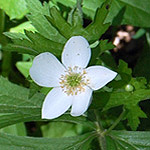
Common Name
Canada Anemone (Canadian Anemone, Meadow anemone)
Scientific Name
Anemone canadensis L.
Plant Family
Buttercup
(Ranunculaceae)
Garden Location
Woodland and Upland
Prime Season
Late Spring to Mid-summer Flowering
Canada Anemone is a native erect perennial forb, growing to 2-1/2 feet high with the flower stalk, which is an a aerial stem from the root, held above the leaves.
The main leaves are large basal leaves which rise from the root on long stalks; they are more broad than long, and deeply palmately divided into 3 to 5 divisions; each division is oblong with a pointed tip and is variously cleft and toothed. The leaf base is either truncate or shaped like an arrowhead. The leaves on the flowering stem are really involucral bracts of the flower, similar in design to the basal leaves but smaller and not stalked and usually in a whorl of 3 and if there is a second tier, that is usually a pair. These are not directly beneath the flowerhead as most bracts are but further down the stalk. The underside of all leaves and bracts may be hairy, the upper surfaces show a distinct vein pattern. Aerial stems of various plant species frequently have bracts but not true leaves.
Flowers are solitary on tall stalks above the bract whorl. The stalk can be smooth to hairy. Rarely are there multiple flowers and then no more than 3. Sepals only, no petals or corolla; usually 5 sepals but there can be 4 to 6 in number. The sepals are white, ovate in shape. The flowerhead has 80 to 100 stamens with yellow anthers. These surround a cluster of yellow-green pistils.
Seed: Fruit at maturity is a dry fuzzy flattened ellipsoid shaped winged seed, 3 - 6 mm x 3.5 - 6 mm, with a persistent style forming a long beak 2 to 6 mm long. These form from the cluster of pistils and separate when mature. Seeds are difficult to germinate. Like most Anemones they require a cold moist resting period followed by a warm moist period and then another cold moist period, with the seed germinating in the second year when planted outside. Best to let nature do it and wait for plants till the 2nd season or transplant a clump of the roots which transplant easily. Seeds must be kept in cold moist storage.
Habitat: Canada Anemone blooms in late spring, usually by June 1st and continues into mid-summer. It is found in parts of the Wildflower Garden in large groups as they grow and spread from caudices and underground rhizomes. It is a plant of open woodlands and cool moist prairies, in full to partial sun. In the home garden it can make a good ground cover beneath trees and shrubs but in a restricted setting it needs control as it is an aggressive spreader. For full flowering potential, it needs a mostly sunny, but somewhat moist area.
Names: The origin of the genus Anemone is obscure but is generally applied to what are called windflowers, and is thought by some to be from the Greek anemos, meaning 'wind.' But the studied opinion (see Stern, Ref. #37a, and Ref. #W7) is that consideration must also given to the god Adonis, who in the Greek myth was killed while hunting a boar and from his blood came a red windflower [Anemone coronaria] and the name is a corruption of an old Semitic word for Adonis. The species canadensis means 'of Canada.' The author name for the plant classification - 'L.' is for Carl Linnaeus (1707-1778), Swedish botanist and the developer of the binomial nomenclature of modern taxonomy.
Comparisons: The large size of this plant with its solitary white flower distinguish it from some white buttercups that have similar looking leaves. The closest species where there may be confusion due to the leaf shape will be the Thimbleweeds, Anemone cylindrica and A. virginiana, but only before flowering time. The Thimbleweeds have a yellow flower with a distinctive center cone.
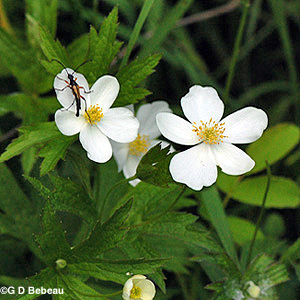
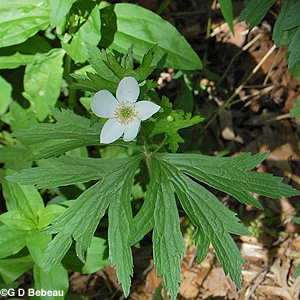
Above: Flowers are single, rarely 2 or 3 on the same stem.
Below: 1st photo - Stamens with yellow anthers are numerous and surround a cluster of yellow-green pistils. 2nd photo - A corolla is lacking. The white color is from the sepals, no petals are present.
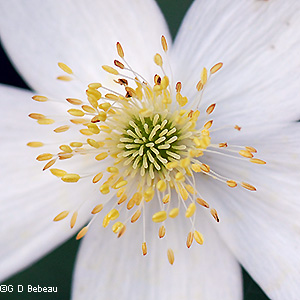
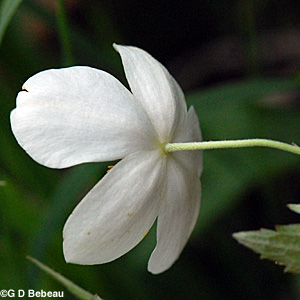
Below: 1st photo - The upper bracts of the flower stem are stalkless and in a whorl. 2nd photo - The lower basal leaves are larger, on long stalks. Both have teeth on the apex of the lobes.
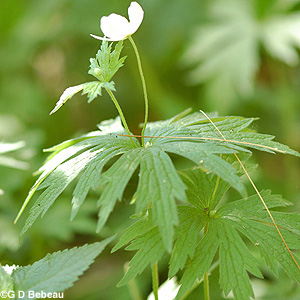
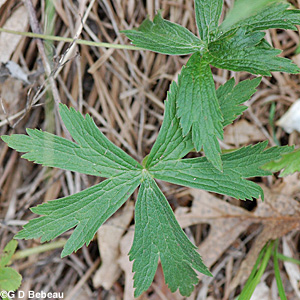
Below: 1st photo - The root has woody caudices with attached rhizomes. The rhizomes are arranged horizontally or ascending. This system allows the plant to spread vegetatively forming colonies. 2nd photo - The flower head forms a cluster of dry fuzzy flattened ellipsoid shaped seeds with a persistent style forming a long beak. At maturity the seeds will disperse.
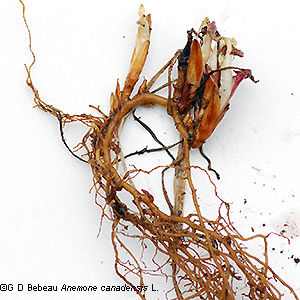
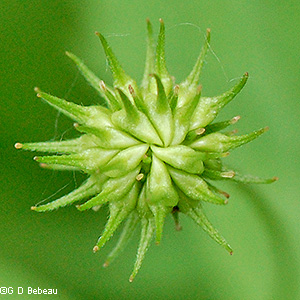
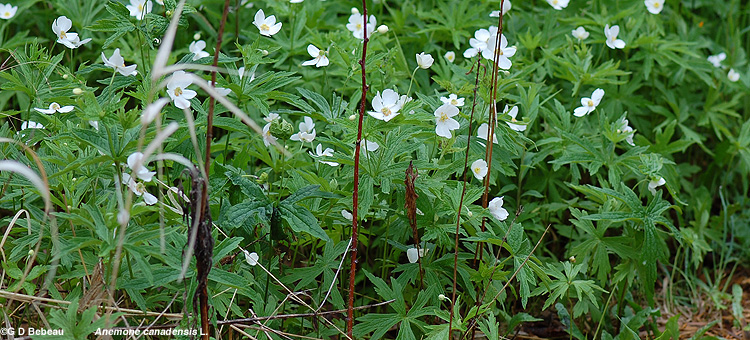
Notes: Canada Anemone is not indigenous to the Garden area, but is an addition. Eloise Butler first introduced it on May 24, 1913 with plants sourced from (strangely, as it is native to MN) Gillett's Nursery in Southwick MA. However, on June 25, 1914 she brought in some plants from Brownie's Pond within Glenwood Park (which surrounded the Garden and is now named Theodore Wirth Park). Martha Crone planted 12 in 1945, again in 1946, and Canada Anemone was listed on her 1951 inventory of plants in the Garden at that time. Cary George planted it and 1998. It is reported as native to all Minnesota Counties except Wadena County. In North America it ranges all across the continent except in the U.S. for the states of the far south and the far west and southwest. In Canada it is found coast to coast.
Eloise Butler wrote of the plants characteristics: "After the Pasque flower, our most conspicuous anemone is the canadensis, once known as the pennsylvanica. On account of a similarity of leaf it is often taken for a white geranium. The anemone, for instance, has no corolla; the white floral leaves are sepals. The Garden Magazine for July has a paper on anemones, especially recommending this species for plantings, and emphasizing the value of white flowers for harmonizing discordant colors and for toning down the hot and violent reds and yellows and outrageous magentas." Published in the Minneapolis Sunday Tribune July 9, 1911 (Read article)
Return to -- Site Plan/Archive Index --or-- List of Common Plant Names -- or -- List of Scientific Names -- or --Home Page - - - Back to top.
References: Plant characteristics are generally from sources 1A, 32, W2, W3, W7 & W8 plus others as specifically applied. Distribution principally from W1, W2 and 28C. Planting history generally from 1, 4 & 4a. Other sources by specific reference. See Reference List for details.
 Identification booklet for most of the flowering forbs and small flowering shrubs of the Eloise Butler Wildflower Garden. Details Here.
Identification booklet for most of the flowering forbs and small flowering shrubs of the Eloise Butler Wildflower Garden. Details Here.
©2014
Friends of the Wildflower Garden, Inc. Text and photos are by G. D. Bebeau unless otherwise credited. "www.friendsofeloisebutler.org"
051923